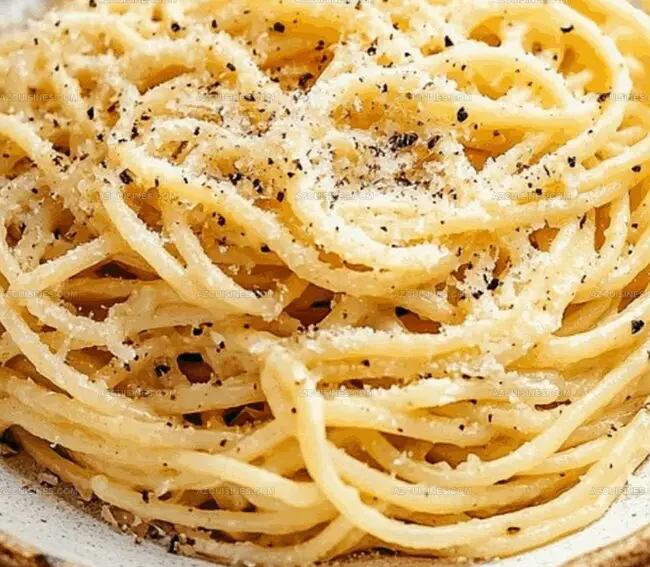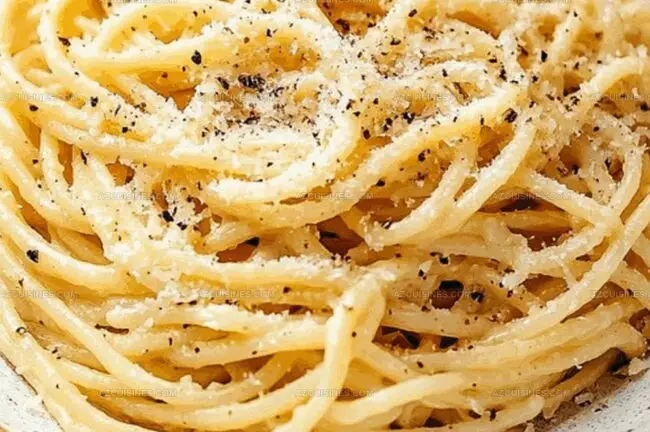The Silky Magic of Cacio e Pepe: An Elegant Roman Recipe
Mastering the art of cacio e pepe brings Italian culinary magic right into your kitchen.
Roman chefs have perfected this deceptively simple pasta dish for generations.
Creamy pecorino romano cheese melts into steaming noodles with sharp black pepper’s bold kick.
Each twirl of spaghetti carries intense flavor that whispers of traditional Roman street food.
Minimal ingredients create maximum satisfaction in this classic recipe.
Pepper’s warmth and cheese’s richness dance together in perfect harmony.
You’ll want to savor every single delectable bite of this authentic comfort meal.
Why Everyone Loves Cacio e Pepe
What You’ll Need for Cacio e Pepe
Pasta Base:Cheese Blend:Flavor Enhancers:Making Cacio e Pepe Without the Fuss
Step 1: Boil Water with Salt
Fill a large pot with water and add a generous amount of salt. Bring the water to a rolling boil, creating the perfect environment for cooking pasta.
Step 2: Prepare Cheese Blend
Finely grate pecorino romano and parmigiano-reggiano cheeses using a microplane or fine grater. Ensure the cheese is light and fluffy for smooth melting.
Ingredients:Step 3: Create Pepper-Infused Base
Warm extra virgin olive oil in a large skillet over medium-low heat. Grind fresh black pepper directly into the warming oil, allowing the spices to release their intense aroma and flavor.
Step 4: Cook Pasta to Perfection
Drop pasta into the boiling salted water. Cook until it reaches al dente texture, typically between 8-10 minutes depending on the pasta type. Stir occasionally to prevent sticking.
Step 5: Capture Pasta Water
Before draining the pasta, scoop out a cup of the starchy cooking water. This liquid gold will help create a silky, creamy sauce later.
Step 6: Combine Pasta and Flavor Base
Transfer the hot pasta directly into the skillet with pepper-infused oil. Toss vigorously, ensuring each pasta strand gets coated with the aromatic base.
Step 7: Create Creamy Cheese Sauce
Gradually sprinkle the grated cheese over the pasta. Continuously stir and add small amounts of reserved pasta water. Keep mixing until a smooth, glossy sauce forms that clings perfectly to the pasta.
Step 8: Final Touches and Serving
Plate the pasta immediately. Garnish with an extra sprinkle of freshly ground black pepper and a light dusting of additional grated cheese. Serve hot to enjoy the rich, robust flavors at their peak.
Simple Tips to Nail Cacio e Pepe
Different Styles to Enjoy Cacio e Pepe
Top Pairings for Cacio e Pepe
How to Keep Cacio e Pepe Fresh and Tasty
Questions and Answers About Cacio e Pepe
The starchy, salty pasta water helps create a smooth, silky sauce by emulsifying the cheese and helping it coat the pasta evenly without becoming too thick or clumpy.
While pecorino romano and parmigiano-reggiano are traditionally used together, you can use just pecorino romano for a sharper flavor, but using both cheeses provides a more complex and balanced taste.
Coarsely grind the black pepper to release its full aromatic essence and provide small bursts of spicy flavor throughout the dish, which is essential to the classic cacio e pepe profile.
Print
Cacio e Pepe Recipe
- Total Time: 20 minutes
- Yield: 4 1x
Description
Cacio e pepe whisks home cooks straight to Roman trattorias with its simple yet luxurious pasta perfection. Creamy pecorino romano and black pepper dance together, creating a classic Italian dish that promises restaurant-quality comfort in mere minutes.
Ingredients
Pasta
- 1 lb (454 g) spaghetti
- 1 lb (454 g) bucatini
Cheese
- 8 oz (226 g) pecorino romano cheese
- 4 oz (113 g) parmigiano-reggiano cheese
Seasonings and Extras
- 2 tbsp (30 ml) black pepper, freshly ground
- 2 tsp (10 ml) salt
- 4 tbsp (60 ml) extra virgin olive oil
- 1/2 cup (120 ml) pasta cooking water
Instructions
- Select a large pot and fill with water, preparing to cook the pasta at a rolling boil with salt.
- Grate both pecorino romano and parmigiano-reggiano cheeses finely, ensuring a smooth, even texture for optimal melting.
- Heat extra virgin olive oil in a large skillet over medium-low temperature, creating a delicate base for the sauce.
- Grind black pepper directly into the warming olive oil, releasing its aromatic essence and allowing the spice to bloom.
- Cook pasta in heavily salted water until it reaches al dente consistency, typically 8-10 minutes depending on pasta type.
- Reserve pasta cooking water before draining, which will help create a silky, emulsified sauce.
- Transfer hot pasta directly into the skillet with infused olive oil and pepper, tossing vigorously to coat each strand.
- Gradually sprinkle grated cheeses over the pasta, continuously stirring and incorporating small amounts of reserved pasta water.
- Continue mixing until a creamy, glossy sauce forms, coating the pasta evenly without becoming too thick or clumpy.
- Plate immediately, garnishing with additional freshly ground black pepper and a light dusting of grated cheese.
- Serve hot, ensuring the dish maintains its rich, robust flavors and smooth, velvety texture.
Notes
- Select high-quality, aged pecorino romano and parmigiano-reggiano for authentic, rich flavor complexity.
- Use freshly cracked black pepper for maximum aromatic intensity and depth of spice.
- Always save pasta water as a crucial emulsification agent that transforms simple ingredients into a silky, creamy sauce.
- Work quickly when combining cheese and pasta to prevent clumping and ensure smooth, glossy texture.
- Prep Time: 10 minutes
- Cook Time: 10 minutes
- Category: Dinner, Lunch, Snacks
- Method: Boiling
- Cuisine: Italian
Nutrition
- Serving Size: 4
- Calories: 698
- Sugar: 1 g
- Sodium: 641 mg
- Fat: 34 g
- Saturated Fat: 10 g
- Unsaturated Fat: 24 g
- Trans Fat: 0 g
- Carbohydrates: 76 g
- Fiber: 3 g
- Protein: 25 g
- Cholesterol: 58 mg




Truc Tran (Kris)
Senior Food Editor
Expertise
Home Cooking, Meal Planning, Recipe Development, Baking and Pastry, Food Editor, Cooking-video Maker, Vietnamese Food Evaluation Expert
Education
Truc Tran (Kris), an experienced food writer and editor, is great at exploring and describing global cuisines, from simple street food to fancy dining. In her writing, she skillfully mixes different flavors, cooking methods, and culinary traditions, showing the unique character of various cultures through their food and drinks. On azcuisines.com, Kris highlights her knowledge, especially in Asian cuisine and worldwide traditional dishes.